Affiliate Disclosure: As an Amazon Associate, I earn from qualifying purchases. When you purchase through these links, I earn a small commission at no additional cost to you. This helps support my ability to provide helpful content for parents. I only recommend products I believe in and would use with my own children.
The best fall learning activities combine seasonal excitement with genuine educational value. Apple-themed learning hits the sweet spot perfectly – kids are naturally drawn to these familiar, colorful fruits while developing essential skills through hands-on exploration.
With apple season in full swing and back-to-school routines settling in, now is the perfect time to introduce apple-themed learning that goes beyond simple crafts. Today I’m sharing educational toys and activities organized by age that will keep your children engaged while building math, science, reading, and fine motor skills. From cooperative board games to hands-on STEM experiments, these apple-themed learning opportunities provide extended engagement while teaching real concepts.
Toddlers & Early Preschoolers (18 months – 3 years)
Skoolzy Apple Factory Counting Set
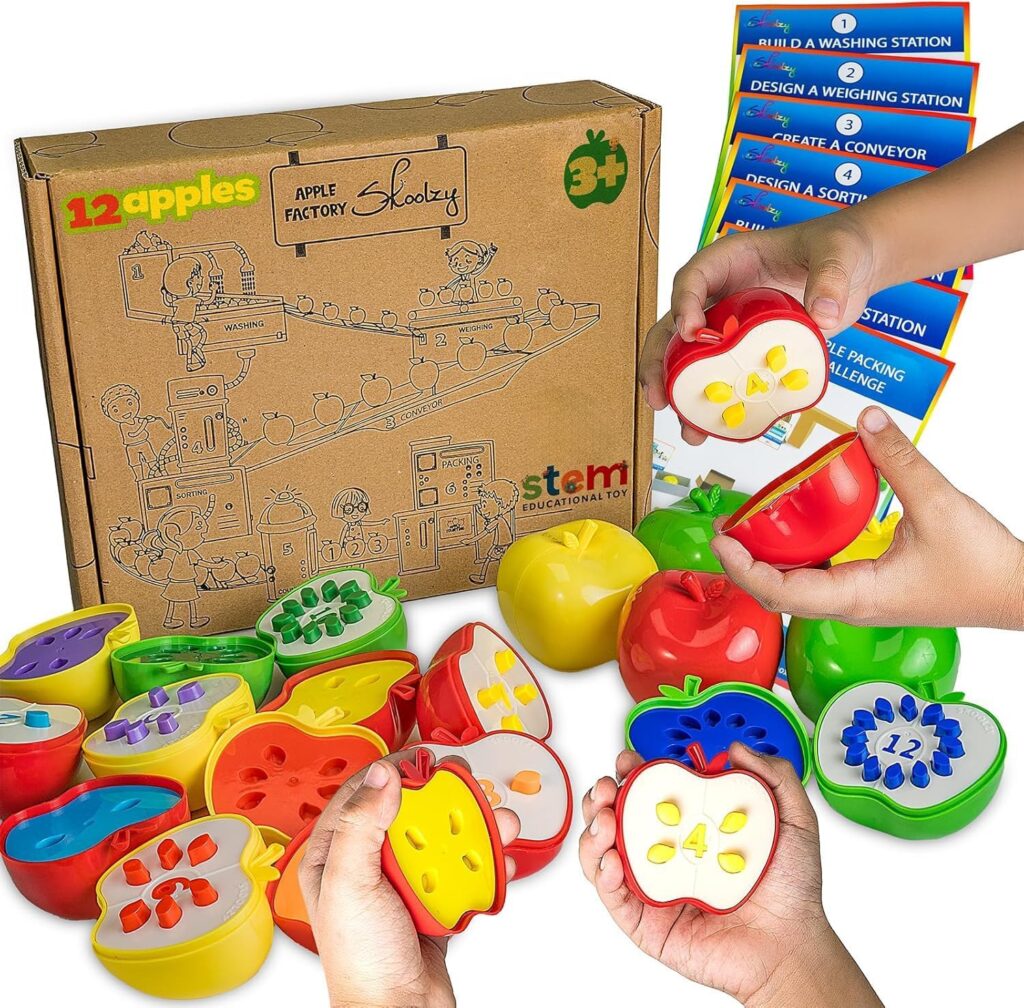
Ages: 18 months+ | Price Range: $24.99 | Engagement Time: 20-30 minutes
https://amzn.to/3IwUbJN (paid link)
These 12 plastic apples split in half to reveal different numbers of seeds inside, making counting visual and hands-on. Each apple opens to show 1-10 seeds, perfect for little hands to practice opening, closing, and matching colors. The set includes STEM activity cards with additional challenges, but even without the cards, toddlers love the simple cause-and-effect of opening the apples to discover what’s inside.
My younger daughter loves sorting them by color first, then trying to fit the halves back together. It’s excellent for developing fine motor skills, early counting concepts, and color recognition. The chunky size is perfect for toddlers who are still developing their pincer grasp, and the bright colors hold attention much longer than traditional counting bears.
Apple Float or Sink Experiment (Activity)
Setup Time: 2 minutes | Active Learning: 10-15 minutes
Fill a large clear bowl with water and let your toddler predict whether an apple will sink or float. Have them hold the apple first to feel its weight, then test their prediction. Most toddlers are genuinely surprised that apples float, leading to great “why?” conversations.
This simple science activity teaches observation skills and introduces basic scientific thinking. Try it with different apple varieties – some float higher or lower depending on their density. It’s perfect for bath time extension or kitchen counter exploration during snack prep.
VTech Alphabet Apple

Ages: 2-5 years | Price Range: $27.99 | Engagement Time: 15-25 minutes
https://amzn.to/46k7p5F (paid link)
This interactive electronic toy features 26 light-up letter buttons that say each letter name and sound, plus play 26 different melodies. The leaf-shaped handle makes it genuinely portable, and the eight different learning modes provide variety that prevents boredom.
What I appreciate most is how it introduces phonics alongside letter recognition – essential pre-reading skills that many electronic toys skip. The volume is adjustable (thank goodness), and it includes both learning games and music modes. Great for car rides, quiet time, or when you need 15-20 minutes of educational entertainment that doesn’t require your constant supervision.
Apple Stamping Art (Activity)
Setup Time: 3 minutes | Creative Time: 15-30 minutes
Cut apples in half horizontally to reveal the natural star pattern, then use them as stamps with washable paint. Toddlers love the process of dipping and stamping, and you’ll end up with beautiful symmetrical prints that actually look artistic.
This activity develops hand-eye coordination, introduces symmetry concepts, and creates artwork you’ll want to display. Use autumn colors like red, orange, and yellow for seasonal appeal. The natural star shape inside apples always surprises young children and leads to discussions about patterns in nature.
Young Builders (3-5 years)
HABA My Very First Games – First Orchard

Ages: 2+ years | Price Range: $34.99 | Engagement Time: 15-20 minutes per game
https://amzn.to/3VxRGd1 (paid link)
This is the cooperative board game with the raven trying to steal fruit from the orchard! Players work together to collect wooden apples, pears, plums, and cherries before the raven reaches the trees. It’s one of the best introductions to board gaming because there are no individual winners or losers – everyone succeeds or fails together.
The game teaches turn-taking, color recognition, counting, and most importantly, cooperation. The wooden fruit pieces are substantial and well-made (this is a German-made toy), and they double as excellent pretend play food for kitchen sets. After three years of regular play, our set still looks almost new.
What makes this special is how it removes the frustration factor from early board gaming. Kids cheer for each other rather than competing, making it perfect for mixed age groups and building positive associations with structured games. Just be careful and watch young kids and maybe be a bit judicious when the raven is activated. I have seen first hand some more sensitive kids being upset by his antics. But of course some kids really get excited!
Apple Volcano Experiment (Activity)
Setup Time: 5 minutes | Reaction Time: 2-3 minutes of fizzing
Hollow out a real apple and create an “apple-cano” using baking soda and vinegar. Mix 2 tablespoons of baking soda inside the apple, then slowly pour in vinegar to create a fizzing eruption. Kids love the surprise element, and it’s a perfect introduction to chemical reactions.
Set this up outside or in the kitchen sink because it can get messy, but the wow factor keeps preschoolers engaged while they learn about cause and effect. Try adding food coloring to make it more dramatic, or use different amounts of baking soda to vary the reaction intensity.
Apple Lacing Toy

Ages: 3+ years | Price Range: $15-20 | Fine Motor Practice: 10-20 minutes
https://amzn.to/4mvlz8M (paid link)
These wooden apple-shaped lacing toys develop fine motor skills and patience as children thread colorful laces through pre-drilled holes. It’s excellent preparation for learning to tie shoes and builds the precise hand control needed for writing letters.
Look for versions with chunky laces that are easier for small fingers to manipulate. The threading motion strengthens the same muscles kids use for pencil grip, making this both immediately engaging and practically useful. My kids often create patterns with the lacing colors, adding an artistic element to the motor skill practice.
Coffee Filter Apple Craft (Activity)
Setup Time: 5 minutes | Creative Time: 20-30 minutes | Drying Time: 30 minutes
Cut coffee filters into apple shapes and let kids paint them with liquid watercolors. As the paint spreads through the filter, it creates beautiful, realistic-looking apple effects. Add construction paper stems and leaves, plus real apple seeds for a complete craft that teaches apple anatomy.
The watercolor spreading effect is almost magical for young children – they’re learning about absorption and color mixing without realizing it. This craft develops creativity, fine motor skills through painting, and introduces scientific observation as they watch colors blend and spread.
Liquid water colors: https://amzn.to/4mt1wb1 (paid link)
Magnetic Apple Tree Toy
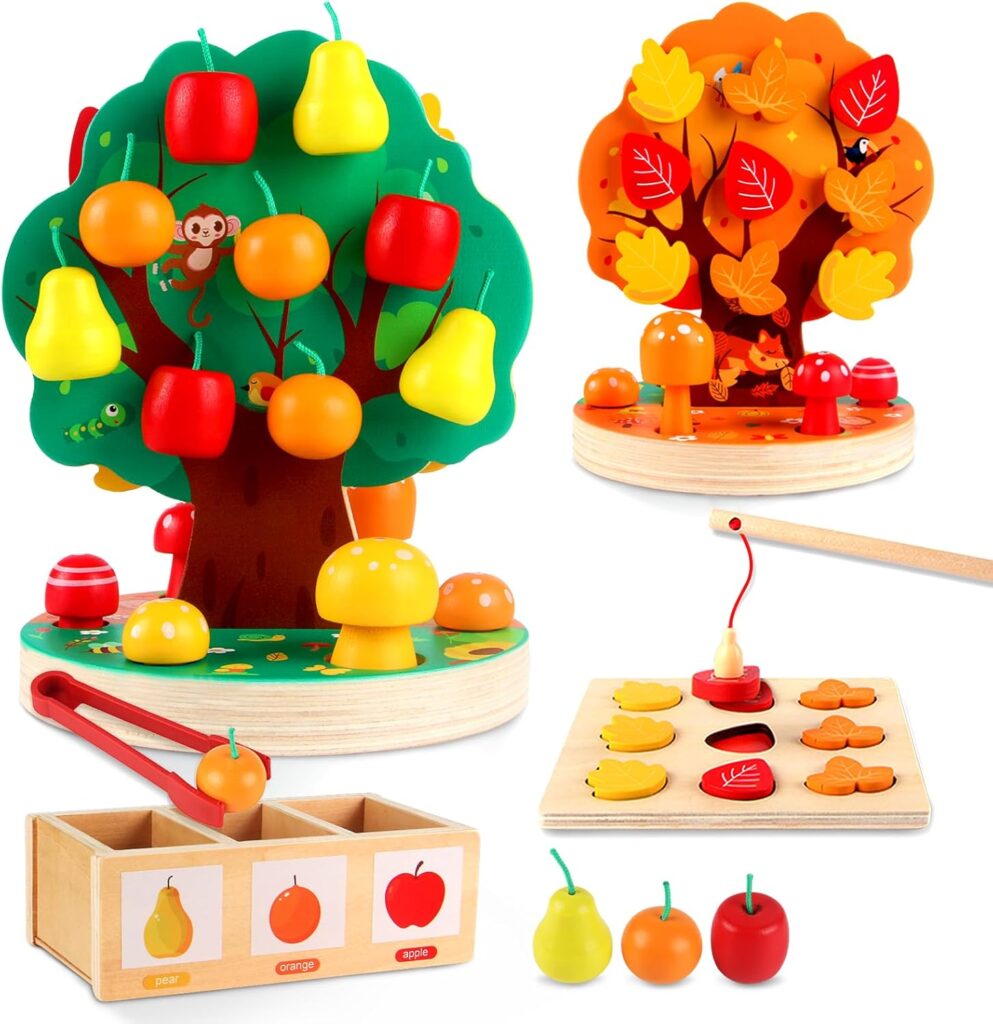
Ages: 3+ years | Price Range: $25-35 | Engagement Time: 15-25 minutes
https://amzn.to/3KimHiT (paid link)
Kids use a magnetic wand to “pick” apples and other fruits from this wooden tree toy. The magnetic wand creates a satisfying “click” when it connects with the magnetic pieces, providing immediate feedback that keeps children engaged longer than regular picking toys.
This strengthens fine motor skills while teaching colors and develops the pincer grasp needed for writing. The magnetic element adds a STEM component as kids experiment with how the magnets work and which pieces the wand will attract. Many versions include multiple fruits and colors for expanded learning opportunities.
Elementary Ages (5-8 years)
Apples to Apples Jr.
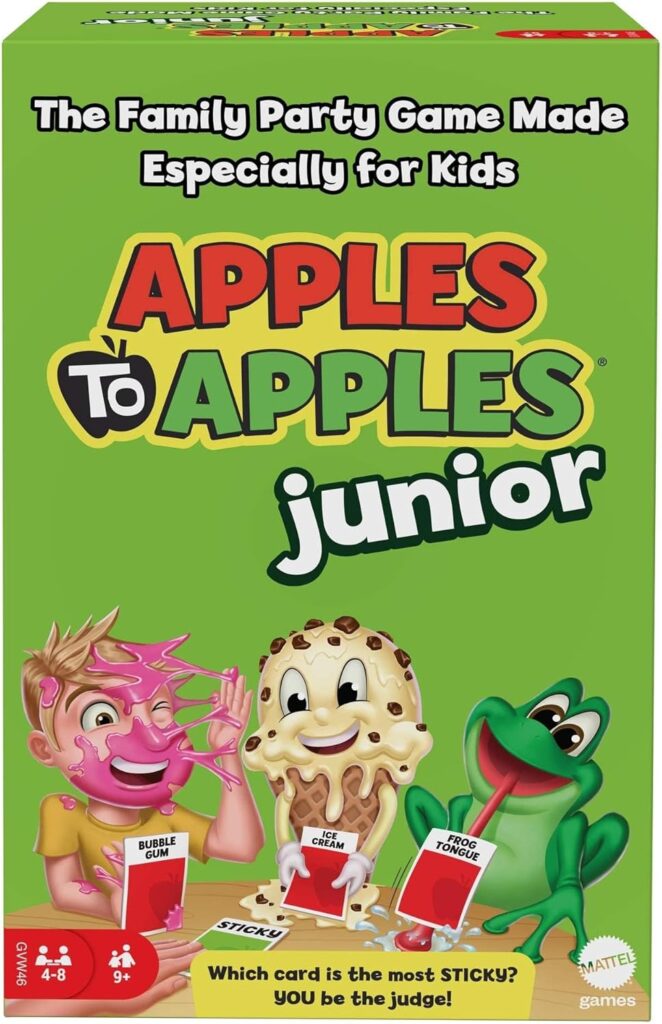
Ages: 6+ years | Price Range: $12-15 | Game Time: 20-30 minutes
https://amzn.to/4niknH4 (paid link)
This family-friendly version of the classic comparison game builds vocabulary and critical thinking as kids match adjectives with nouns in creative ways. Players compare combinations like “loud apples” or “scary apples,” which develops reasoning skills and gets everyone laughing together.
The junior version uses simpler vocabulary and picture cards alongside words, making it accessible for emerging readers while still challenging enough for adults. It builds confidence in expressing ideas and defending choices – important skills that transfer to academic discussions and creative writing.
Apple Fractions Activity (Activity)
Prep Time: 2 minutes | Learning Time: 15-20 minutes | Snack Time: Ongoing
Cut real apples into halves, quarters, and eighths to make fractions visual and edible. Kids can physically see how four quarters make a whole apple, and eating the “math” makes abstract concepts concrete and memorable.
Start with halves and work up to smaller fractions as kids grasp the concepts. Use different colored apples to make the activity more visually interesting. This hands-on approach helps children understand that fractions represent parts of a whole, laying important groundwork for more advanced math concepts.
Apple Seed Investigation (Activity)
Investigation Time: 10-15 minutes | Discussion Time: 5-10 minutes
Cut apples both horizontally (to see the star pattern) and vertically (to see the traditional apple shape) to explore internal structure. Count seeds in different apple varieties, observe the core, flesh, and skin layers, and compare how different cuts reveal different information.
This develops scientific observation skills and introduces botanical concepts like seed formation and fruit structure. Kids are always surprised by the natural star pattern inside apples. Extend the learning by trying to sprout apple seeds in wet paper towels to observe germination.
Apple Balance STEM Challenge (Activity)
Setup Time: 3 minutes | Challenge Time: 20-30 minutes
Using paper towel rolls, plastic cups, and real apples, challenge kids to create balanced structures and towers. This engineering activity teaches problem-solving, gravity, and spatial reasoning while strengthening hand muscles needed for writing.
Kids experiment with different configurations, learning through trial and error how weight distribution affects stability. The activity naturally progresses from simple balancing to complex multi-level structures. It’s perfect for developing persistence and problem-solving skills while exploring physics concepts.
Apple-Scented Cloud Slime
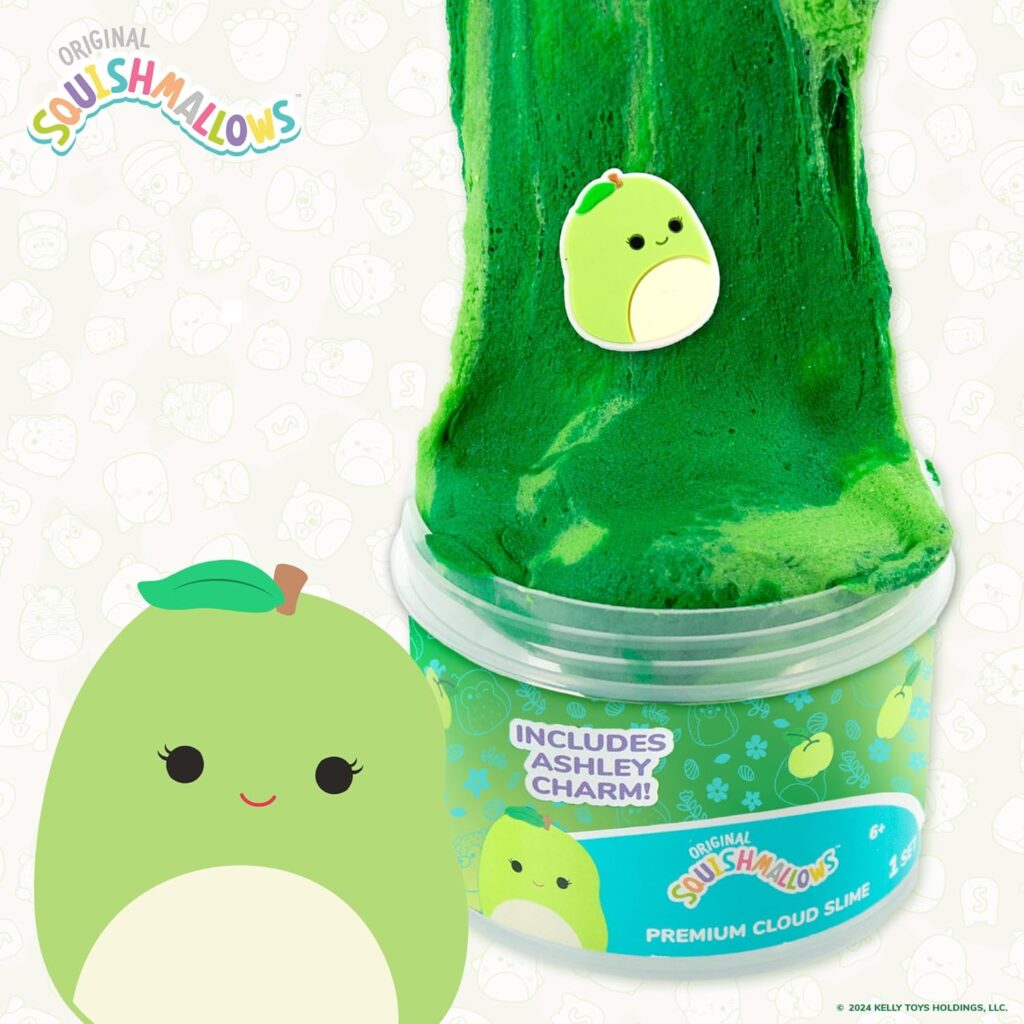
Ages: 5+ years | Price Range: $8-12 | Sensory Play Time: 10-20 minutes
https://amzn.to/46Sug8A (paid link)
This pre-made sensory material provides stress relief while engaging multiple senses. The apple scent adds realism to pretend play scenarios, and the stretchy, moldable texture is perfect for fidgeting during homework breaks or when kids need sensory input to focus.
The cloud slime texture is particularly satisfying – it’s fluffy, stretchy, and holds its shape better than regular slime. Great for kids who need sensory breaks during academic work, and the apple theme ties perfectly into seasonal learning themes.
Advanced Builders (8+ years)
Apple Oxidation Experiment (Activity)
Setup Time: 10 minutes | Observation Period: 2-4 hours | Results Discussion: 10 minutes
Test what prevents apples from browning by creating a controlled experiment with different solutions: lemon juice, salt water, plain water, and air exposure. Kids form hypotheses, conduct controlled tests, and draw conclusions based on observed results.
This introduces the scientific method and real chemistry concepts (oxidation) in an engaging, edible format. Have kids create data charts to track browning over time and discuss why acidic solutions prevent oxidation. It’s perfect for science fair projects or extended learning investigations.
Apple Tasting & Graphing (Activity)
Tasting Time: 15 minutes | Graphing Time: 10-15 minutes | Discussion: 10 minutes
Compare different apple varieties (Honeycrisp, Granny Smith, Red Delicious, Gala) and create graphs of family preferences. This combines math skills with sensory exploration and introduces data collection, analysis, and presentation concepts.
Kids develop descriptive vocabulary as they identify differences in sweetness, tartness, texture, and appearance. Create bar graphs, pie charts, or pictographs to represent the data. This activity naturally leads to discussions about preferences, statistics, and how data can be represented visually.
Advanced Apple Play Dough Mats (Activity)
Prep Time: 5 minutes | Creative Challenge Time: 20-40 minutes
Create complex apple-themed challenges like making specific numbers of apples on trees, creating patterns with red and green apples, or building 3D apple orchards with play dough. Older kids can design their own challenges and create instruction cards for younger siblings.
This develops spatial reasoning, mathematical thinking, and creativity while building fine motor strength. Kids practice following complex directions and then flip the script by creating challenges for others. The teaching component reinforces their own learning while developing leadership and communication skills.
Pro Tips for Apple-Themed Learning Success
Storage and Preparation: Keep a dedicated apple learning bin with basic supplies: measuring cups for experiments, washable paint for stamping, and extra apples for spontaneous activities. Having materials ready makes it easier to extend learning moments when kids show interest.
Cross-Curricular Connections: Combine apple activities with seasonal books like “Ten Apples Up on Top” by Dr. Seuss or “The Seasons of Arnold’s Apple Tree” by Gail Gibbons. Reading connections deepen understanding and provide vocabulary for discussing observations.
Safety Considerations: Always supervise knife use during apple cutting activities. For younger children, use child-safe knives or pre-cut apple pieces. When doing chemistry experiments, explain that we only mix safe household materials and never experiment with unknown substances.
Extending the Learning: Save apple seeds for spring planting activities, photograph science experiment results for future reference, and keep artwork samples to show progress over time. These extensions help children see learning as an ongoing process rather than isolated activities.
Making Apple Learning Work for Your Family
The key to successful apple-themed learning is matching activities to your child’s current interests and developmental level while gradually introducing new challenges. Start with activities that feel like play – the HABA Orchard game or apple stamping – then build toward more complex investigations like the oxidation experiment.
Remember that learning doesn’t have to be perfect or Pinterest-worthy. The goal is engagement and skill development, not professional-looking results. Some of our best apple learning happened spontaneously during snack preparation when my kids started asking questions about why some apples are sweeter than others.
Whether you choose structured toys like the counting apples or simple activities like floating experiments, apple-themed learning provides natural opportunities for math, science, creativity, and family connection. The seasonal timing makes these activities feel special while building skills that support academic success throughout the year.
These apple learning opportunities prove that educational activities can be both genuinely fun and academically valuable. From toddler-friendly stamping to elementary-level chemistry experiments, apple-themed learning grows with your child while creating positive associations with exploration and discovery.
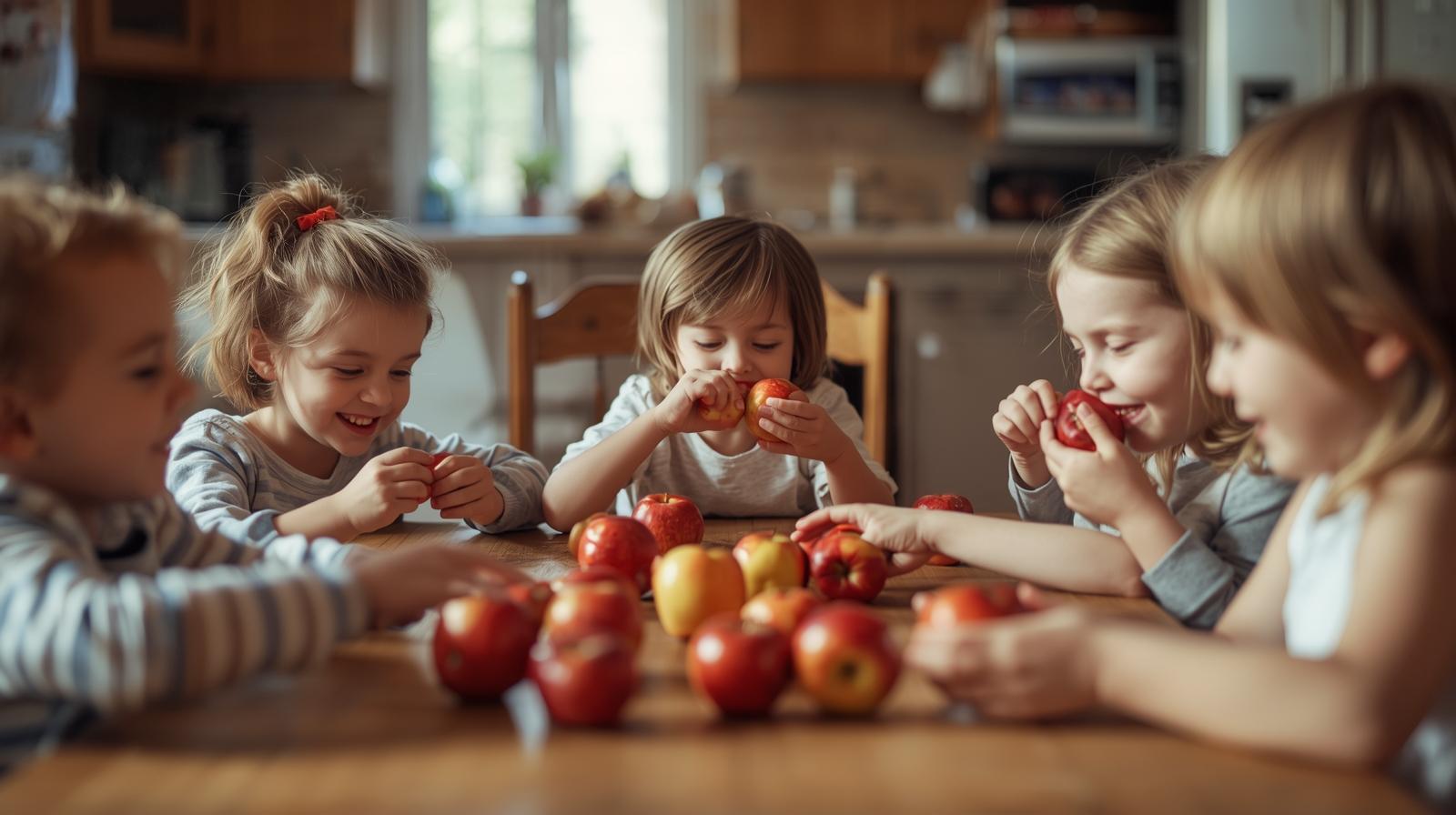
Leave a Reply